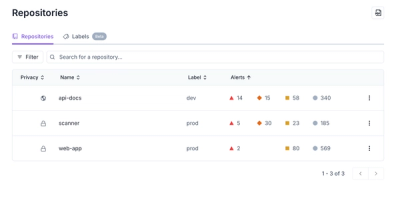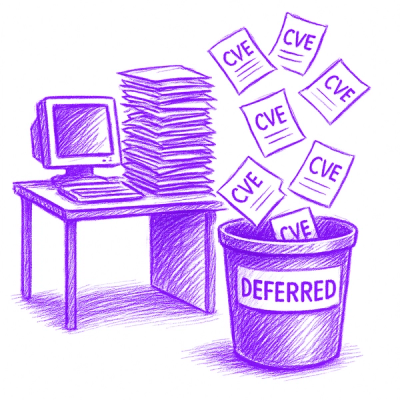
Product
Redesigned Repositories Page: A Faster Way to Prioritize Security Risk
Our redesigned Repositories page adds alert severity, filtering, and tabs for faster triage and clearer insights across all your projects.

| Documentation | Tutorial videos | Linux | MacOS | Windows | PyPI |
|---|---|---|---|---|---|
 |  |
Mitsuba 3 is a research-oriented rendering system for forward and inverse light transport simulation developed at EPFL in Switzerland. It consists of a core library and a set of plugins that implement functionality ranging from materials and light sources to complete rendering algorithms.
Mitsuba 3 is retargetable: this means that the underlying implementations and data structures can transform to accomplish various different tasks. For example, the same code can simulate both scalar (classic one-ray-at-a-time) RGB transport or differential spectral transport on the GPU. This all builds on Dr.Jit, a specialized just-in-time (JIT) compiler developed specifically for this project.
Cross-platform: Mitsuba 3 has been tested on Linux (x86_64), macOS
(aarch64, x86_64), and Windows (x86_64).
High performance: The underlying Dr.Jit compiler fuses rendering code into kernels that achieve state-of-the-art performance using an LLVM backend targeting the CPU and a CUDA/OptiX backend targeting NVIDIA GPUs with ray tracing hardware acceleration.
Python first: Mitsuba 3 is deeply integrated with Python. Materials, textures, and even full rendering algorithms can be developed in Python, which the system JIT-compiles (and optionally differentiates) on the fly. This enables the experimentation needed for research in computer graphics and other disciplines.
Differentiation: Mitsuba 3 is a differentiable renderer, meaning that it can compute derivatives of the entire simulation with respect to input parameters such as camera pose, geometry, BSDFs, textures, and volumes. It implements recent differentiable rendering algorithms developed at EPFL.
Spectral & Polarization: Mitsuba 3 can be used as a monochromatic renderer, RGB-based renderer, or spectral renderer. Each variant can optionally account for the effects of polarization if desired.
We've recorded several YouTube videos that provide a gentle introduction Mitsuba 3 and Dr.Jit. Beyond this you can find complete Juypter notebooks covering a variety of applications, how-to guides, and reference documentation on readthedocs.
We provide pre-compiled binary wheels via PyPI. Installing Mitsuba this way is as simple as running
pip install mitsuba
on the command line. The Python package includes thirteen variants by default:
scalar_rgbscalar_spectralscalar_spectral_polarizedllvm_ad_rgbllvm_ad_monollvm_ad_mono_polarizedllvm_ad_spectralllvm_ad_spectral_polarizedcuda_ad_rgbcuda_ad_monocuda_ad_mono_polarizedcuda_ad_spectralcuda_ad_spectral_polarizedThe scalar variants perform one-ray-at-a-time simulations, while the LLVM and CUDA variants can be used for inverse rendering on the CPU or GPU respectively. To access additional variants, you will need to compile a custom version of Dr.Jit using CMake. Please see the documentation for details on this.
Python >= 3.8Nvidia driver >= 495.89LLVM >= 11.1Here is a simple "Hello World" example that shows how simple it is to render a scene using Mitsuba 3 from Python:
# Import the library using the alias "mi"
import mitsuba as mi
# Set the variant of the renderer
mi.set_variant('scalar_rgb')
# Load a scene
scene = mi.load_dict(mi.cornell_box())
# Render the scene
img = mi.render(scene)
# Write the rendered image to an EXR file
mi.Bitmap(img).write('cbox.exr')
Tutorials and example notebooks covering a variety of applications can be found in the documentation.
This project was created by Wenzel Jakob. Significant features and/or improvements to the code were contributed by Sébastien Speierer, Nicolas Roussel, Merlin Nimier-David, Delio Vicini, Tizian Zeltner, Baptiste Nicolet, Miguel Crespo, Vincent Leroy, and Ziyi Zhang.
When using Mitsuba 3 in academic projects, please cite:
@software{Mitsuba3,
title = {Mitsuba 3 renderer},
author = {Wenzel Jakob and Sébastien Speierer and Nicolas Roussel and Merlin Nimier-David and Delio Vicini and Tizian Zeltner and Baptiste Nicolet and Miguel Crespo and Vincent Leroy and Ziyi Zhang},
note = {https://mitsuba-renderer.org},
version = {3.1.1},
year = 2022
}
FAQs
Mitsuba 3: A Retargetable Forward and Inverse Renderer
We found that mitsuba demonstrated a healthy version release cadence and project activity because the last version was released less than a year ago. It has 1 open source maintainer collaborating on the project.
Did you know?

Socket for GitHub automatically highlights issues in each pull request and monitors the health of all your open source dependencies. Discover the contents of your packages and block harmful activity before you install or update your dependencies.

Product
Our redesigned Repositories page adds alert severity, filtering, and tabs for faster triage and clearer insights across all your projects.

Security News
Multiple deserialization flaws in PyTorch Lightning could allow remote code execution when loading untrusted model files, affecting versions up to 2.4.0.

Security News
NVD now marks all pre-2018 CVEs as "Deferred," signaling it will no longer enrich older vulnerabilities, further eroding trust in its data.